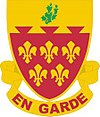Aerial Rocket Artillery
| 2nd Bn, 20th Artillery | |
|---|---|
| Active | 1965-1972 |
| Country | United States |
| Allegiance | USA |
| Branch | Army |
| Type | Aerial artillery |
| Role | General support artillery |
| Part of | 1st Cavalry Division |
| Nickname(s) | Armed Falcon{early ARA} then changed to"Blue Max"for duration. |
| Motto(s) | "Duty not Reward" |
| Mascot(s) | Griffin |
| Engagements | "many" |
| Commanders | |
| Notable commanders |
LTC Mahone 65/66, LTC Brady 66/66, LTC Farwell 66/67,LTC Knowles 67/67, LTC Tyson 67/68, LTC Franklin 68/69, LTC Schnibben Jr. 69/69, LTC Bunyard 69/70, LTC Morris 70/70, LTC Toepel Jr. 1970/1971 {unit Deactivated in Fort Lewis WA on April 10, 1971} |
Aerial rocket artillery (abbreviated ARA, also called aerial artillery) is a type of armed helicopter unit that was part of the artillery component of the United States Army's two airmobile divisions during the Vietnam War. Controlled by division artillery and not the aviation group, the 2nd Battalion, 20th Artillery, 1st Cavalry Division and the 4th Battalion, 77th Artillery, 101st Airborne Division, along with Battery F, 79th Artillery, 1st Cavalry Division, were the only ARA units fielded during that conflict. The ARA concept disappeared from Army aviation by the mid-1970s, replaced by more generic attack aviation units.
After the helicopter demonstrated its early battlefield capabilities in the Korean War, the United States Army began experimenting with expanded roles and missions for them. This culminated in 1962 with the formation of the Tactical Mobility Requirements Board, which strongly recommended the adaptation of helicopters in a variety of roles and missions. In 1963, the 11th Air Assault Division was activated to test a number of the Board's concepts and recommendations about air mobility. Because the 155mm howitzers then assigned to Army divisions as medium support artillery were not transportable by helicopters, the concept of aerial rocket artillery (ARA) was developed as a substitute. The original test unit for rocket-armed helicopters within the 11th Air Assault Division was the 2nd Battalion, 42nd Artillery (later designated the 3rd Battalion, 377th Artillery). When the 11th Air Assault was redesignated as the 1st Cavalry Division and sent to Vietnam, the 3/377th became the 2nd Battalion, 20th Artillery (using the radio call sign "Blue Max"). This was the first unit designated and organized as ARA to take part in combat operations. The 4/77th Artillery joined the 101st Airborne Division in 1969 when the 101st was converted to an airmobile division, becoming the second active ARA battalion. Battery F, 79th Artillery, was formed to serve with the separate 3d Brigade of the 1st Cavalry Division when the rest of the division was withdrawn from Vietnam. It was the final ARA unit to see combat service.
...
Wikipedia


